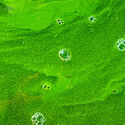Harmful algae blooms poses threat to pets in Tri Cities
September 16, 2021

Courtesy
Toxic algae blooms can be deadly for both humans and animals. Headlines coming out of California last month were a testament to the deadly nature of toxic blooms. In August, a Northern California couple, their one-year-old daughter and the family dog were found dead on a remote trail in the Sierra National Forest, near Mariposa, Calif. The couple were reported to be avid hikers. The trail and surrounding areas were initially closed and treated as hazmat sites over concerns that potentially toxic gases were being released from old nearby mines, the LA Times reported, but gases were ruled out. Now, officials are investigating the possibility of toxic algae or other hazards that may have contributed to the deaths.
At least three dogs have fallen victim to toxic algae bloom on the Columbia River, just north of the Tri-Cities.
The first report was received by the Benton Franklin Health District on Monday, September 13, and by the end of the day, the health officials were looking into the death of two other dogs who were swimming near Leslie Groves and Howard Amon parks.
All three dogs are suspected to have been affected by Harmful Algae Bloom, or HABS, rapid growth of algae or cyanobacteria (blue-green algae) that can be harmful to people, animals, and the local ecology.
HABS can look like foam, scum, or mats on the surface of the water, and colors vary, according to the Centers for Disease Control (CDC). The blooms can occur in freshwater, including lakes and rivers, and bodies of saltwater, including the ocean and salt water bays.
Symptoms may vary slightly depending on the water that the bloom is thriving in. Symptoms will also differ depending on how long the person or dog was exposed, how they were exposed, and which type of toxin they were exposed to.
Animals and people may be exposed to cyanotoxins by skin contact with water while swimming, drinking contaminated water, breathing in tiny droplets that contain certain toxins, eating fish or shellfish that contain toxins, and eating contaminated blue-green algae nutritional supplements.
Human symptoms that occur after touching or swimming in contaminated water, or breathing in contaminated air, include irritation of the eyes, nose, throat, and lungs.
Eating contaminated shellfish or supplements may result in symptoms that include stomach pain, headache, dizziness, muscle weakness, vomiting, diarrhea, and liver damage.
Symptoms in dogs and other mammals include excessive salivation, vomiting, fatigue, staggered walking, difficulty breathing, convulsion, liver failure, and death within hours or days.
Avoid bodies of water that show signs of HABS. If you suspect a toxic bloom, do not let pets or livestock drink or swim in the water, and do not let dogs lick potentially harmful water off of their coats. Avoid grazing or eating near the water, and do not let dogs eat dead animals, including fish, found near the water. The mats of algae may look like a play toy to water-loving pups, but do not let them eat the algae.
If you have come in contact with a harmful bloom, call your healthcare provider immediately- the same goes for dogs, livestock, and other animals. Call the vet!













Reader Comments(0)